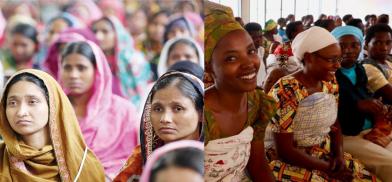Bangladesh and Rwanda: Two economic success stories in two continents underpinned by women
As the International Monetary Fund (IMF) released its World Economic Outlook for 2020, the report has drawn heated, but detailed and significant, discussions in India

As the International Monetary Fund (IMF) released its World Economic Outlook for 2020, the report has drawn heated, but detailed and significant, discussions in India. The reason: Bangladesh has overtaken India in terms of per capita GDP. The outcome somewhat confused many as people were unaware of the difference between overall GDP size and per capita GDP. But the projection - that Bangladesh surpassed India on per capita GDP - led to some reports in the media underlining some consistent factors and efforts Bangladesh has made on the human development front to achieve these results.
Among several reforms and steps, the role of women and girls' education still remained one of the least discussed and underappreciated reforms that positively contributed to the economic miracle of the country.
Among their South Asian countries, Bangladesh - led by a woman prime minister, Sheikh Hasina - is the only country that achieved gender parity in primary education. And this is not something easy to achieve especially in developing nations. Acknowledging the fact, the World Bank commended the country as “a rare example”.
Many schools operate in two shifts to make sure no one will be left behind. Bangladesh has its fair share of population living in slums, so the government crafted its program keeping in mind that the schools have to be made accessible to these slum children.
The World Bank financed the third Primary Education Development Program aimed at increasing participation in primary education, completion of primary education, and enhancing the learning outcome. The project cost $400 million. In 2015, the country increased its enrollment to 90% which was 80% in 2000. Surprisingly, girls’ enrollment in secondary education surpassed that of boys in 2015.
Investment in girls’ education has paid off. Today the textile sector and manufacturing sectors - which form the backbone of the country's export market - are witnessing the women workforce on a scale never seen before. The textile industry houses more than 80% of the workforce in the form of women.
The increased women's workforce produced an unintended good outcome for the nation - reduced fertility rate. Working women intend to delay pregnancy and are more likely to opt for better family planning. Once infamous for its exploding population, the country managed to reduce its growth significantly.
The economic miracle through women's empowerment isn’t an isolated case for Bangladesh. In fact, it has many parallels with Rwanda in East Africa.
In 1994, Rwanda was devastated by an ethnic conflict - more than 800,000 people were killed within 100 days. Twenty-six years later, the same nation is the fastest growing economy in Africa. The common link between the growth stories of both nations, Bangladesh and Rwanda, is the participation of women in the workforce and public life.
For Rwanda, the challenge was even bigger - to heal a divided nation from a past filled with gruesome ethnic cleansing. The reconciliation process started by its visionary leader and President Paul Kagame who put women in the center of the strategy.
The country reaped dividends not only in form of social reconciliation but also in the economic segment. Government data, in 2010, stated that the employment rate of women, 85.2% surpassed that of men, 83.2%. Since 2010, Rwanda has posted an average growth rate of 7%.
Moreover, the increased participation of women in public life also acts as a safeguard against fundamentalism in society. It’s an insurance, and investment, nations can afford to vouch for, to keep their society relatively secure, stable, and progressive. Bangladesh and Rwanda are compelling case studies for other nations to follow.
(The writer is a researcher with SPS. The views expressed are personal. He can be contacted at snbhatnagar296@gmail.com)










Post a Comment